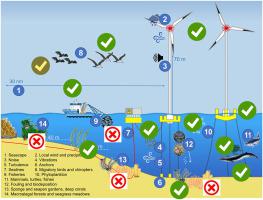当前位置:
X-MOL 学术
›
Renew. Sust. Energ. Rev.
›
论文详情
Our official English website, www.x-mol.net, welcomes your feedback! (Note: you will need to create a separate account there.)
Making eco-sustainable floating offshore wind farms: Siting, mitigations, and compensations
Renewable and Sustainable Energy Reviews ( IF 15.9 ) Pub Date : 2024-03-28 , DOI: 10.1016/j.rser.2024.114386 Roberto Danovaro , Silvia Bianchelli , Paola Brambilla , Gaia Brussa , Cinzia Corinaldesi , Adriana Del Borghi , Antonio Dell’Anno , Simonetta Fraschetti , Silvestro Greco , Mario Grosso , Ettore Nepote , Lucia Rigamonti , Ferdinando Boero
Renewable and Sustainable Energy Reviews ( IF 15.9 ) Pub Date : 2024-03-28 , DOI: 10.1016/j.rser.2024.114386 Roberto Danovaro , Silvia Bianchelli , Paola Brambilla , Gaia Brussa , Cinzia Corinaldesi , Adriana Del Borghi , Antonio Dell’Anno , Simonetta Fraschetti , Silvestro Greco , Mario Grosso , Ettore Nepote , Lucia Rigamonti , Ferdinando Boero

|
Floating Offshore Wind Farms (FOWFs) are the most promising renewable energy resource. Floating turbines are installed at progressively increasing water depths, interacting with offshore and deep-sea ecosystems. Thus, specific criteria to enable a sound and accurate Environmental Impact Assessment (EIA) are required. The still limited understanding of the impacts of FOWFs, and the concerns for the conflicts in the use of maritime space (e.g., fisheries), might lead to a more precautionary approach and constrain their development. Here we describe the characteristics of the deep habitats potentially impacted and identify a set of comprehensive and standardized criteria, response variables and approaches for a reliable EIA based on an Ecosystem-based approach. These analyses will support an appropriate design and site prioritization to respect the “Do No Significant Harm" principle. Considering the wide heterogeneity among habitats and geographic regions, we examined the potential interactions of FOWFs with i) Vulnerable Marine Ecosystems; ii) critical habitats; iii) migratory routes of large marine vertebrates; iv) habitat-forming species, benthic/pelagic organisms, v) migratory routes of birds/chiropters; vi) other human uses leading to cumulative/synergistic effects and any other potential interference. We identified mitigation and compensation measures and explored the potential of wind-farm areas as “Other Effective Conservation Measures” to support sustainable fisheries and passive restoration. Adequate siting, EIA and systematic monitoring can minimize FOWFs’ environmental interactions, with final negligible, or even positive effects on marine ecosystems. Standardized criteria could significantly reduce the bottlenecks in permitting while offering a strategic vision for the sustainable use of the maritime space.
中文翻译:

打造生态可持续的浮动海上风电场:选址、缓解措施和补偿
浮动海上风电场(FOWF)是最有前途的可再生能源。浮动涡轮机安装在逐渐增加的水深处,与近海和深海生态系统相互作用。因此,需要制定健全、准确的环境影响评估(EIA)的具体标准。对FOWF影响的了解仍然有限,以及对海洋空间(例如渔业)使用冲突的担忧,可能会导致采取更加谨慎的做法并限制其发展。在这里,我们描述了可能受到影响的深层栖息地的特征,并确定了一套全面且标准化的标准、响应变量和方法,以基于生态系统的方法进行可靠的环境影响评估。这些分析将支持适当的设计和场地优先顺序,以尊重“不造成重大伤害”的原则。考虑到栖息地和地理区域之间的广泛异质性,我们研究了 FOWF 与 i) 脆弱海洋生态系统;ii) 关键栖息地;以及 ii) 潜在的相互作用。 iii) 大型海洋脊椎动物的迁徙路线; iv) 栖息地形成物种、底栖/远洋生物; v) 鸟类/翼手目动物的迁徙路线; vi) 导致累积/协同效应和任何其他潜在干扰的其他人类利用。和补偿措施,并探索风电场地区作为“其他有效保护措施”的潜力,以支持可持续渔业和被动恢复。适当的选址、环境影响评估和系统监测可以最大限度地减少 FOWF 的环境相互作用,最终对环境的影响可以忽略不计,甚至是积极的。标准化标准可以显着减少许可瓶颈,同时为海洋空间的可持续利用提供战略愿景。
更新日期:2024-03-28
中文翻译:

打造生态可持续的浮动海上风电场:选址、缓解措施和补偿
浮动海上风电场(FOWF)是最有前途的可再生能源。浮动涡轮机安装在逐渐增加的水深处,与近海和深海生态系统相互作用。因此,需要制定健全、准确的环境影响评估(EIA)的具体标准。对FOWF影响的了解仍然有限,以及对海洋空间(例如渔业)使用冲突的担忧,可能会导致采取更加谨慎的做法并限制其发展。在这里,我们描述了可能受到影响的深层栖息地的特征,并确定了一套全面且标准化的标准、响应变量和方法,以基于生态系统的方法进行可靠的环境影响评估。这些分析将支持适当的设计和场地优先顺序,以尊重“不造成重大伤害”的原则。考虑到栖息地和地理区域之间的广泛异质性,我们研究了 FOWF 与 i) 脆弱海洋生态系统;ii) 关键栖息地;以及 ii) 潜在的相互作用。 iii) 大型海洋脊椎动物的迁徙路线; iv) 栖息地形成物种、底栖/远洋生物; v) 鸟类/翼手目动物的迁徙路线; vi) 导致累积/协同效应和任何其他潜在干扰的其他人类利用。和补偿措施,并探索风电场地区作为“其他有效保护措施”的潜力,以支持可持续渔业和被动恢复。适当的选址、环境影响评估和系统监测可以最大限度地减少 FOWF 的环境相互作用,最终对环境的影响可以忽略不计,甚至是积极的。标准化标准可以显着减少许可瓶颈,同时为海洋空间的可持续利用提供战略愿景。



























 京公网安备 11010802027423号
京公网安备 11010802027423号